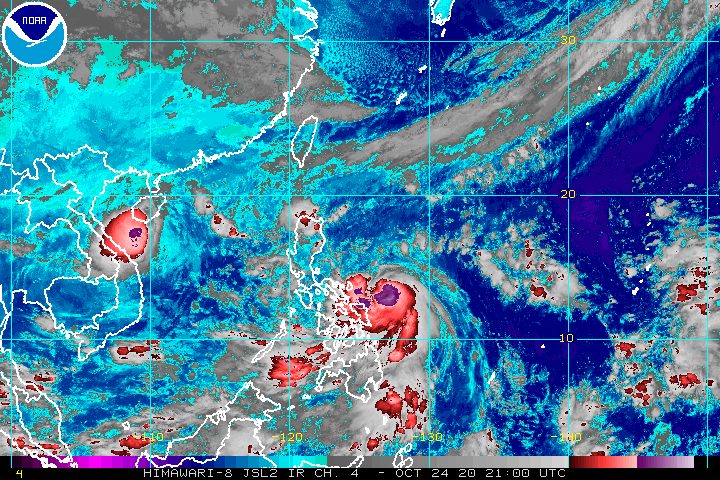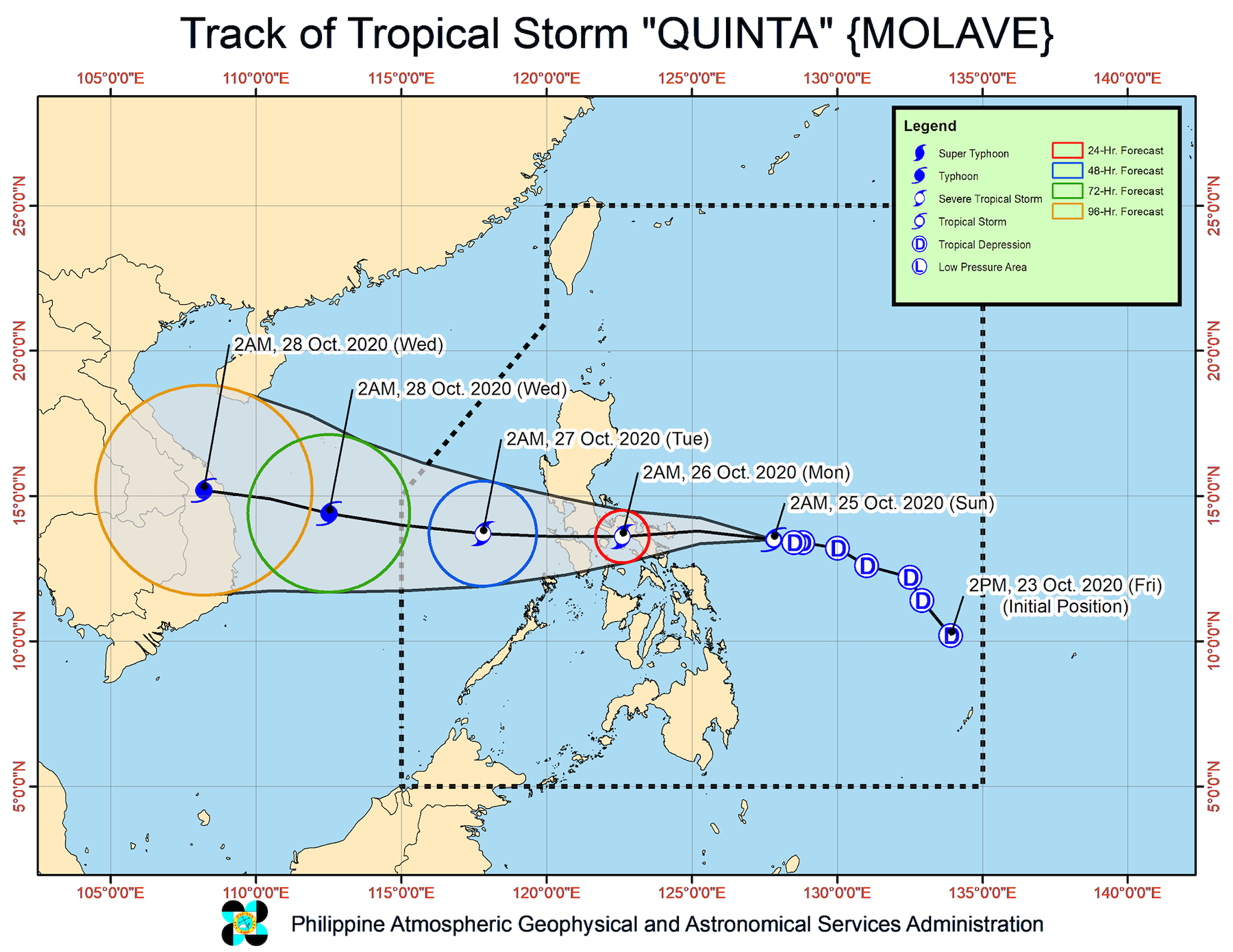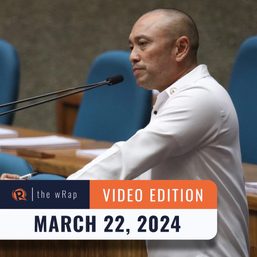SUMMARY
This is AI generated summarization, which may have errors. For context, always refer to the full article.

Quinta strengthened from a tropical depression into a tropical storm before dawn on Sunday, October 25, as it moved closer to the region of Bicol.
It was given the international name Molave, a name contributed by the Philippines which refers to a hardwood tree popularly used in furniture, said the state weather bureau.
In a bulletin issued 5 am on Sunday, the Philippine Atmospheric, Geophysical, and Astronomical Services Administration (PAGASA) said Tropical Storm Quinta (Molave) is already 345 kilometers east of Virac, Catanduanes.
It is moving west at 20 kilometers per hour (km/h) as of 5 am, after earlier slowing down to 10 km/h as of 2 am.
PAGASA said Quinta is now expected to make landfall either in Catanduanes, Albay, or Sorsogon on Sunday afternoon or evening, earlier than its previous forecast of landfall between Sunday evening and early Monday morning, October 26.
After hitting land, Quinta will cross Southern Luzon until Monday afternoon or evening, then emerge over the West Philippine Sea.
As of 5 am on Sunday, its maximum winds increased from 55 km/h to 65 km/h, while its gustiness is now up to 80 km/h from the previous 70 km/h.
PAGASA warned that the possibility of Quinta intensifying further into a severe tropical storm before hitting Bicol is still not ruled out.
After crossing land, it could intensify again over the West Philippine Sea and become a typhoon by Tuesday evening, October 27. (READ: FAST FACTS: Tropical cyclones, rainfall advisories)
As Quinta strengthened, Signal No. 2 was raised for the first time due to the weather disturbance. Below is the latest list of areas under tropical cyclone wind signals as of 5 am on Sunday.
Signal No. 2
- Catanduanes
- Camarines Norte
- Camarines Sur
- Albay
- Sorsogon
- northern part of Masbate (Baleno, Aroroy, Masbate City) including Burias and Ticao Islands
- southern part of Quezon (Perez, Alabat, Quezon, Calauag, Guinayangan, Tagkawayan, Buenavista, San Narciso, San Andres, San Francisco, Mulanay, Catanauan, Lopez, General Luna, Macalelon, Gumaca, Pitogo, Unisan, Plaridel, Atimonan, Agdangan)
- Marinduque
Signal No. 1
- rest of Masbate
- rest of Quezon
- Laguna
- Rizal
- Batangas
- Cavite
- Metro Manila
- Bulacan
- Pampanga
- Bataan
- southern part of Zambales (San Marcelino, San Felipe, San Narciso, Castillejos, Subic, San Antonio, Olongapo City, Botolan, Cabangan)
- Occidental Mindoro
- Oriental Mindoro
- Romblon
- Northern Samar
- northern part of Samar (Calbayog City, Santa Margarita, Santo Niño, Almagro, Tagapul-an, Gandara, San Jose de Buan, Matuguinao, San Jorge, Tarangnan, Pagsanghan)
- northern part of Eastern Samar (Maslog, Dolores, Oras, Jipapad, Arteche, San Policarpo)
PAGASA said gale conditions will be experienced in areas under Signal No. 2, while strong breeze to near gale conditions will be felt in areas under Signal No. 1.
Strong breeze to gale conditions from a northeasterly surge will also persist in the following areas:
- Batanes
- Babuyan Islands
- northern coastal areas of Ilocos Norte and mainland Cagayan
As for rainfall, below is PAGASA’s latest rainfall forecast for Quinta, plus the tail-end of a frontal system which is also affecting parts of the country. The forecast covers Sunday until Monday morning.
Moderate to heavy rain, with at times intense rain (Quinta)
- Bicol
- Calabarzon
- Aurora
- Occidental Mindoro
- Oriental Mindoro
- Romblon
- Marinduque
- Calamian Islands
- Northern Samar
- Eastern Samar
- Samar
- Biliran
- Aklan
- Antique
Moderate to heavy rain, with at times intense rain (tail-end of a frontal system)
- northern parts of mainland Cagayan including Babuyan Islands, Apayao, and Ilocos Norte
Light to moderate rain, with at times heavy rain (Quinta and tail-end of a frontal system)
- Metro Manila
- Cordillera Administrative Region
- rest of Central Luzon
- rest of Mimaropa
- rest of Cagayan Valley
- rest of Visayas
- Zamboanga Peninsula
- Bangsamoro Autonomous Region in Muslim Mindanao
- Northern Mindanao
- Caraga
These areas must be on alert for possible floods, landslides, and “sediment-laden streamflows” such as lahar in areas near Mayon Volcano which may occur during heavy or prolonged rain.
PAGASA warned that travel is risky in seaboards with rough to very rough waters, especially for small vessels.
Rough to very rough seas
- seaboards of Northern Luzon (waves 3 to 5.5 meters high)
- areas under Signal Nos. 1 and 2 (waves 2.5 to 5.5 meters high)
- seaboards of Aurora, Zambales, and northern part of Palawan including Calamian and Kalayaan Islands (waves 2.5 to 4.5 meters high)
Those with small vessels should also take precautionary measures as waters elsewhere are moderate to rough.
Moderate to rough seas
- other seaboards of the Philippines (waves 1.2 to 2.8 meters high)
“Inexperienced mariners should avoid navigating in these conditions,” added the state weather bureau.
Based on its latest forecast track, Quinta might leave the Philippine Area of Responsibility (PAR) on Tuesday afternoon.

Quinta is the Philippines’ 17th tropical cyclone for 2020, and the 4th for October.
An average of 20 tropical cyclones form within or enter PAR each year. (READ: LIST: PAGASA’s names for tropical cyclones in 2020)
These are PAGASA’s latest estimates for the number of tropical cyclones inside PAR in the next 6 months:
- November 2020 – 1 to 3
- December 2020 – 2 or 3
- January 2021 – 0 or 1
- February 2021 – 0 or 1
- March 2021 – 0 or 1
- April 2021 – 0 or 1
Last October 2, the state weather bureau warned Filipinos to expect more rain in the coming months due to the onset of La Niña. – Rappler.com
Add a comment
How does this make you feel?




There are no comments yet. Add your comment to start the conversation.